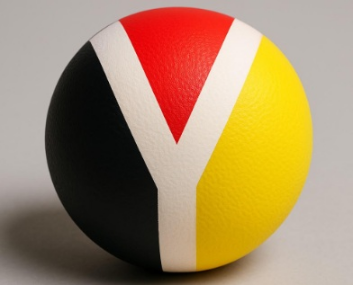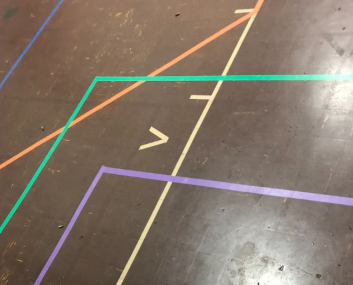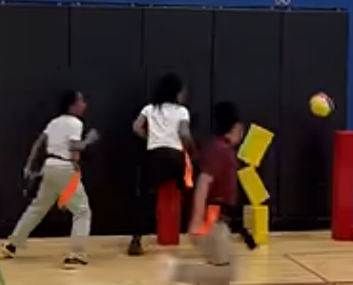Rules & Equipment
13 Original Rules of Bdoteball ™
Glossary
Keep– Back area of the House; where the blocks are set up.
House– Blocking area for Keepers.
Tower– Stack of 3 blocks.
Offensive and Defensive rebounding– Possession after a shot attempt.
Keeper– Position in Bdoteball, designated player that will be blocking in the team’s House.
Emphasis on blocking, defensive rebounding, passing.
Knight– Position in Bdoteball, referring to the area on the sides of the House in relationship with the back wall. 6 feet up and 6 feet over as it makes an L combining the wall and the House lines. (‘Knight’ is from chess terminology because of how Knights move in an L pattern.)
Emphasis on defensive flag pulling, defensive rebounding, blocking.
- For players that wanted to be a Keeper but could not be, a Knight is great for not having to move as much and still have a lot of impact on the game.
Midfielder– Position in Bdoteball by playing in the middle of the field
Emphasis on passing, defensive flag pulling, scoring.
Attacker– Position in Bdoteball by playing across the offensive foul lines
Emphasis on scoring, offensive rebounds, passing.
Fumble– When an offensive player is carrying the ball near their flags and the defensive player knocks the ball out on a flag pull.
Dead ball penalty shot– Penalty shot is taken with no chance for a rebound. The player who took the shot will maintain possession on a reset.
Live penalty shot– Penalty shot is taken and once the ball hits the back wall play resumes live.
Shooting Violation– Stepping over the House lines while trying to score.
Early Flag pull-taking a player’s flag before they make contact with the ball
Mark– Stepping into the opposing team’s House or your own House as a non-Keeper.
Black and Yellow Team– Hawks
Red and White– Eagles
Equipment
18 Blocks for Bdote scoring system, 1 foot tall, 6 inches long, 6 inches wide
Flag Belt and two flags for each player
7-inch diameter dodgeball, preferably low-density
Painters’ tape to create the House, Keep, starting line, and block placement
Setting Up the Game
Setting Up the Towers
The Keep will be located at the center of the wall or boundary on the short side of the playing area (putting the longest distance available between the Keeps, which face each other across the playing area). Towers should be set up 1 foot from the wall, and 1 foot apart, measured from the side of the blocks. First, find the center of the playing area against one of the far walls. To achieve this, take a block and place its square end against the wall at the midpoint, then stand it up at the edge, leaving 1 foot between the base of the block and the wall, measured from the side of the block. Then place two blocks together on each side of the middle tower, and stand them up on edge, leaving 2 feet between the towers, measured from the side of the blocks. Put 6 inches of tape down directly in front of the 3 towers to mark their positions for quick resets. Stack each tower three blocks high.
Refer to the picture below.
Creating the House & Keep
Measure 3 feet into the court from the midpoint of the back wall to identify the top of the Keep and mark with tape. Measure 3 feet, 7 inches on each side of the mark for a total boundary of 7 feet, 2 inches long: the top of the keep. Tape this boundary. Connect each endpoint to the back wall with 3 feet of tape at a 90 degree angle.
Measure 10 feet into the court from the midpoint of the back wall to identify the peak of the House. Measure 7 feet along the back wall on each side of the midpoint for a total boundary of 14 feet for the base of the House. From each endpoint, measure 6 feet into the court for the top of each wall of the House. Connect the top of each wall directly to the peak of the House to complete the top of the House.
Refer to the picture below.
The last thing to mark is the starting lines/offensive fouls lines for each side. Approximately 4-5 feet ahead of the top of the house.
Gameplay Overview
You can play 1 vs 1 up to 10 vs 10 in a half gym. The greater the space the more players you can add. To determine 1st possession a player from each team takes a penalty shot. If it is a tie the younger player starts with the ball.
- Starting gameplay/reset
Teams will start on their own respective starting lines. Designated as the foul lines on each side. Keepers start in the House.
- Resets happen after a non-shooting foul, injury, or score.
- Possession
A player must have both flags to possess the ball, and 1 flag for 1 tap/touch. Touching the ball (with your hands) a 2nd time with only 1 flag is a turnover. Touching the ball with no flags is also a turnover.
- Correctly attach flags on each hip, over the shirt.
- If the ball touches a player in a different area of the body, play continues. Must touch your hands for a turnover to occur.
- After you lose possession of the ball you may go pick up your flag and reattach it.
- No intentional kicking of the ball, doing so is a turnover reset.
- If you touch the ball with any body part, your flag is able to be pulled for 1 second
- Radius Rule
If your flag is removed, you have 3 seconds to get rid of the ball or it is a turnover. After a flag is pulled, “stalling” is called followed by “3,2,1.” On “1” the player needs to have advanced the ball or be in the act of throwing (arm back going forward). If the player is in the act of throwing, play should continue. The defensive player should drop the flag on the ground to create a 10 foot radius that the offensive player must stay within to advance the ball. Leaving the 10 foot radius results in a turnover. If the Defensive player holds onto the flag or throws it to create advantage, a “free” call is made before “stalling”. The free call allows the runner to go beyond the normal 10 foot radius while adhering to the stall count.
- Players can only remove one flag at a time. Another teammate would need to remove the second flag.
- Radius is determined by the 1st flag pull.
- Taking off the 2nd flag only affects scoring. The stall count stays the same. Scoring with no flags upon release of the ball results in no score.
- Grades 4th and below the radius rule is optional. Grades 5th-8th, optional but encouraged to use a radius rule. Grades 9-12 should be playing with a radius rule. If the playing surface is smaller than recommended, a shorter distance can be enforced, down to 9 or 8 feet. It is also optional to shrink the radius size for grades 9-12 to increase the difficulty.
- Scoring
Knocking down the blocks with the ball is how you score points. Blocks are placed in the Keep area. Blocks must be totally down on the ground for them to count (all 4 rectangular corners touching the ground). Middle blocks are worth 2 points, outside blocks are worth 1 point. The highest single score in Bdoteball is 12 points. If you let go of the ball before a flag is pulled, the scoring is 100%. If you score with only 1 flag remaining, the score is cut in half and rounded down. (For example: a 9 point shot would only be worth 4 points because half of 9 is 4 ½.). No points are awarded for a score where the ball was thrown with no flags remaining.
- After blocks get knocked down from a scoring attempt or a Keeper knocks over their own blocks, there is a reset and the blocks are restacked. The team that knocked down their own blocks scores the blocks ½ rounded down and possession goes to the scoring team
- You cannot touch the blocks in your own House. Touching falling blocks results in the entire stack of 3 blocks being scored from that tower (3 points for the outer towers, 6 points for the middle tower).
- No readjusting blocks midpoint, blocks that shifted without a successful score must stay that way until a reset happens.
- The House/Keepers
Only Keepers can be in the House, Entering the other team’s House is an automatic turnover, even if you personally do not possess the ball. On a turnover, play resets. Keepers may leave the House, but cannot be replaced mid-point. Keepers are designated each time play starts/resets.
- If someone steps into the House and makes a shooting violation but does not knock over any blocks and possession is with the defensive team, play can continue.
- Players cannot run into the House after a shot is scored. If this happens it is treated as a turnover and no points are awarded.
- Keepers can be changed after a reset but never during the point.
- The Keep
Keepers cannot stand in the Keep and touch the ball. Keepers may have half of 1 foot in the Keep while touching the ball. Keepers cannot have one full foot or both feet half in the Keep while touching the ball. Doing so results in a live penalty shot.
- The player’s foot needs to be both across and on the Keep boundary line to be considered a half foot in the keep.
- If a player enters their own team’s House as a non-Keeper they have a silent “Stalling” call made against them followed by a silent 3-second call, and on “1” there is a penalty assessed to that team. The other team will take a live penalty shot. If 2 players or more enter the House as a non-Keeper, the penalty is automatically assessed.
- You can enter the House with possession of the ball. A “stalling” call is made starting at “5”. If the counter calls “1” before the player is in the act of throwing, it is a turnover
- Total number of Keepers is typically made by how many people are playing on each team divided by 3. Max of 3.
- Keepers can pick up the ball from a missed shot in the Keep and have one full foot in the Keep.
- If Keepers knock over their own blocks the score is cut in half and rounded down, as if the other team scored with 1 flag on. The scoring team maintains possession of the ball.
- If the Keepers touch the blocks of a falling tower, the entire tower is scored, unless the contact to the blocks is deemed accidental.
- Penalty shots
Penalty Shots are typically taken at the 3 point line or, in a half gym, at the corresponding side of the full court basketball paint. If it is a typical penalty shot, play will continue live after the ball hits the back wall. Players from the shooting team’s side cannot be standing ahead of the penalty shot player. Players from the defending team cannot be standing in front of the Keep and must be out of the House, including the Keepers. All players can move after the ball hits the wall. If it is a flagrant foul, there is a dead ball penalty shot, after which the ball is returned to the shooting player and a reset takes place.
- The player’s width of where they can place their foot matches up with the Keep.
- The closest a defender can be on a penalty shot is the edge of the House giving a clear path for the shooter.
- After a successful score, play resets.
- 24 points to win the game. Games are always within two scores. Two 12 point shots would end the game. There is no official time limitation, but games last on average 20 minutes. In the event of an external time limitation, the winner of an incomplete game is the team with the most points when gameplay ends. Last ball should be called when there are roughly two minutes remaining for gameplay.
- Offensive Line/Fouls
Fouls past the Offensive line also result in a live penalty shot. Fouls beyond the offensive line are possession unless deemed to be a flagrant foul. Flagrant fouls are considered excessive and not within the nature of play. If it is a flagrant foul there is a dead ball penalty shot, after which the ball is returned to the shooting player and a reset takes place.
- Two flagrant fouls results in the ejection of the player from the game.
- Four fouls results in the ejection of the player from the game.
- Taking the ball out of someone’s hands is a foul.
- The principles of Defensive “blocks” and offensive “charges” are present in Bdoteball. A player cannot step directly in front of someone to stop their momentum and the offensive player cannot excessively run into a set defensive player.
- Defensive Flag Pulling
A player must have 1 flag on to pull an opposing player’s flag. Targets must be in possession of the ball or have just touched it with another body part. If the opposing team pulls a flag before a player contacts the ball it is considered an “early flag pull”. Early flag pulls result in possession and a reset (for the player whose flag was pulled off before touching the ball) if the player takes possession of a loose ball, an “early flag pull” call is made and the player whose flag was pulled early can run as if they have 2 flags and without stalling. If he/she scores it is worth full points. The other team needs to take his/her 2nd flag for a stall count to start.
- You cannot take the ball out of someone’s hands, you must always take the flag off to create the stall count and radius.
- Exception: if a defensive player reaches to grab a flag and the ball is contacted on the reach in and is dropped, a “fumble” is called and it is a live ball.
- Fouls/Marks
Four team fouls results in the opposing team shooting a dead ball penalty shot, after which they retain possession. If you enter the opposing team’s House or your own House it is considered a “mark”, the 4th time is considered a foul. Every two times after that would be assessed as another foul.
- This rule is enacted to prevent players who are not Keepers from entering the House
- For grades 4th and below the marks rules do not apply for assessing fouls. Grades 5th-8th are optional. Grades 9th-12th should be using the marks rules
- Knees/Contact Rule
You cannot touch the ball on your knee or knees. If you slip and have possession of the ball you may get up and play can continue. If you are contacted by another player in contact not worthy of a foul and your knee touches, “contact” is called and play can continue. Players after a contact call may release the ball from their knee or knees.
Because no foul was called the player can still have their flags pulled off. The stall call starts at 5 and there is still a 10 foot radius on the player. If the player scores and a flag was pulled and “contact” was called they score half points because it was simply a “contact” call and not a foul call. If contact was called and they score with no flags on half points are awarded.
- 13. Player Etiquette – Respect yourself, your team and your opponent. Bdoteball was made to be inclusive. If someone wants to play, try to invite them into the game. They may not play but offering is a big part of creating a safe environment. Apprehensive people may want to watch a little bit of gameplay before getting involved. Inviting them in early gives them the green light to join when they are ready with little to no pressure.
Try to be positive no matter the outcome. Winning should never come at the cost of someone’s confidence. If someone makes a mistake try to be understanding and stay positive. Remember, the game was made to be fun and, in the spirit of competition, never meant to bring people down. The etiquette of Bdoteball is to be thankful for the opportunity to experience the sacred bond that sport brings to society. Memories that last until we pass to the next journey. Live in each moment with grace, humility and love, realizing that your actions always speak loudly. You have the ability to change someone’s life when you treat them with simple kindness. Thank you for playing.

Rules & Equipment
Here you will find a detailed list of the rules of Bdoteball, the equipment needed to play, diagrams/dimensions of the court, and anything else you may need to start playing.

History of Badoteball
Bdoteball was created in the Fall of 2018 as an outlet for skill and sportsmanship. Click below to learn the history of Bdoteball, and follow how the game has evolved to where it is today.

Teaching Manual
COMING SOON. Click below to read or download a comprehensive Badoteball teaching manual.
